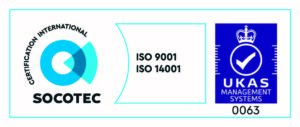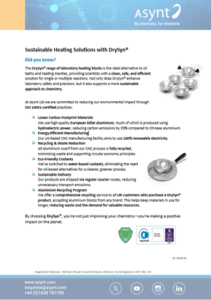Asynt is committed to working smarter to further sustainability in the modern laboratory.
We invest energy, time and money in finding responsible and sustainable solutions for the laboratory and our own workplace which have the most positive impact possible on our environment on both a personal and a global scale. Our main aim being to reduce the depletion of natural resources, minimize waste and observe the changing mentality to pursue alternatives to utilizing dangerous chemicals and substances. Our team of engineers work hard to manufacture products best suited to reduce the carbon footprint and increase scientists productivity in an environmentally positive way, at the same time saving space, money and time.
ISO 14001 accredited
We are proud to be ISO 14001 accredited. ISO 14001 is an internationally agreed standard that sets out the requirements for an environmental management system.
It helps organizations improve their environmental performance through more
efficient use of resources and reduction of waste. You can find further information on our ISO accreditation here: www.asynt.com/iso-quality-environmental-policies/

Make a change
We believe that if we start by making small changes, bigger ones will follow. Something as simple using a DrySyn® heating block for example, which negates the need for the regular disposal of oil from a bath, uses 35% less energy, allows us a cleaner laboratory with fewer spills to clean up, and cleaner air to breathe.
We also pride ourselves in reducing laboratory water consumption using our air cooled CondenSyn® units and water circulators.
With high demand from our customers, we developed the CondenSyn waterless condenser to effectively replace the Liebig condenser across multiple laboratory functionalities thus reducing flood risk and water consumption.
The average rate of water used in a condenser is 2 litres per minute; this rate was confirmed by a major UK research institution as the average measured use per water condenser in their facility. The water costs used below are at £1.22 per cubic metre supply and £1.56 per cubic metre waste which is equivalent to 0.28p per litre. This commercial rate cost is from a water supplier here in the UK, Anglian Water (Wave) in March 2022.
As we progress we use the equipment in our laboratories to work in a smarter way; by using manifolds to combine chillers and rotary evaporators, utilising antibacterial solutions and regular servicing to give our apparatus a longer lifespan to reduce landfill waste and embracing technology to automate systems and control use of costly consumables just to name a few changing methods.
It doesn’t end in the lab though!
Working sustainably is integral to the way Asynt carries out its business. We are transitioning to electric vehicles for those with company cars, investing in solar power for our UK headquarters, recycling within both our offices and our warehouses, and making major changes to the way we package and ship our products around the world.
In addition, we no longer produce paper copies of the majority of our company/product literature as providing digital copies gives our customers all the information they require, and we are working to ensure that use of our website involves the least amount of power usage possible by using more compact images and smart server solutions to reduce data download times.
Our state of the art digital demonstration suite is another way we’re reducing our environmental impact. Our team of experts can now provide training, product demonstrations, webinars, and meet with our customers for discussions all online without any travelling. This is far better use of our time, your time, and the world’s resources. If you’d like to talk to us about this please do contact us.
We’re in this together
As long as we continue to keep an open mind and remember how precious our world is and how important it is to protect it, we will continue to strive to improve. Please join Asynt in our commitment to enable these solutions and harness the power within all of our reach to protect our environment.
If you’d like to find out what we’re doing to improve lab safety and download our FREE Best Practice Guide for safe laboratory heating then click HERE.

